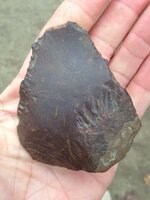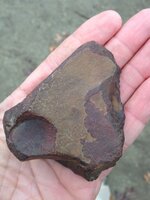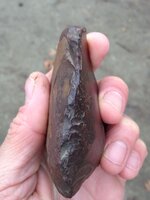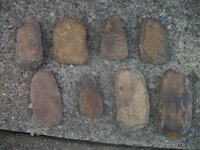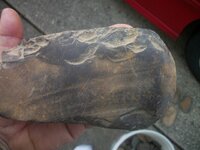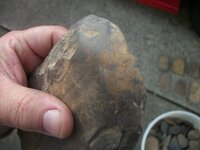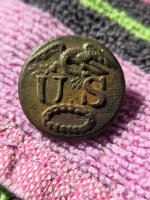You are using an out of date browser. It may not display this or other websites correctly.
You should upgrade or use an alternative browser.
You should upgrade or use an alternative browser.
material id please
- Thread starter reuellis
- Start date
theviking
Bronze Member
This may help. From "The People Of The Stone" by Tom Kuhn.
WEST VIRGINIA: In general, two types of cherts are named from West Virginia sources. The most common and widespread of these materials is the well-known KANAWHA BLACK. Not even a chert, these are large depositional materials of layered non-limestone related materials. They are exclusively black, and often large tools will reveal significant whitish cortex. Often deposited by the prehistoric Teays River system throughout the central Ohio Valley/West Virginia region as large cobbles of irregular size and shape, the chippable black material is only revealed upon breaking into the whitish deposits. Additionally, extremely large blocks, often weighing several tons, can be found in the tributaries of the upper Kanawha River above Charleston, WV such as Campbell's Creek and Paint Creek. However, this material is generally of poor quality for chipping. Only the extremely weathered material that had been exposed for thousands of years was selected by Native American flintknappers. Sometimes the best of this material is quite glossy when flaked, but other samples indicate attempts to improve the workability by firing, with some redness revealed. However, firing does not seem to bring the glossiness or color range, due to the absence of pyrites and other inclusions. While useful to prehistoric peoples because of its widespread distribution and easy availability, it is of generally poor quality and difficult to work. The texture is reminiscent of slate or basalt, however, and it does produce a quality sharp edge when flaked. I have, however, seen excellent Early Archaic and even Paleo-Indian pieces of this material, indicating a high degree of competence on the part of those early flintknappers, as well as an intimate knowledge of the few good sources of this widespread material.. Another type of less common flint from central and eastern West Virginia is the LEWISBURG FLINT. This is a gray material similar in color and texture to the Onandaga described above, and is often misidentified as such. However, it is generally more of a cobble deposited chert with a quite grainy and difficult to flake nature, unless obtained directly from the few eastern WV deposits. - See more at: FINDING THE FLINT: Identifying the Source Can Be Both Helpful and Easy to Do | The People of the Stone
WEST VIRGINIA: In general, two types of cherts are named from West Virginia sources. The most common and widespread of these materials is the well-known KANAWHA BLACK. Not even a chert, these are large depositional materials of layered non-limestone related materials. They are exclusively black, and often large tools will reveal significant whitish cortex. Often deposited by the prehistoric Teays River system throughout the central Ohio Valley/West Virginia region as large cobbles of irregular size and shape, the chippable black material is only revealed upon breaking into the whitish deposits. Additionally, extremely large blocks, often weighing several tons, can be found in the tributaries of the upper Kanawha River above Charleston, WV such as Campbell's Creek and Paint Creek. However, this material is generally of poor quality for chipping. Only the extremely weathered material that had been exposed for thousands of years was selected by Native American flintknappers. Sometimes the best of this material is quite glossy when flaked, but other samples indicate attempts to improve the workability by firing, with some redness revealed. However, firing does not seem to bring the glossiness or color range, due to the absence of pyrites and other inclusions. While useful to prehistoric peoples because of its widespread distribution and easy availability, it is of generally poor quality and difficult to work. The texture is reminiscent of slate or basalt, however, and it does produce a quality sharp edge when flaked. I have, however, seen excellent Early Archaic and even Paleo-Indian pieces of this material, indicating a high degree of competence on the part of those early flintknappers, as well as an intimate knowledge of the few good sources of this widespread material.. Another type of less common flint from central and eastern West Virginia is the LEWISBURG FLINT. This is a gray material similar in color and texture to the Onandaga described above, and is often misidentified as such. However, it is generally more of a cobble deposited chert with a quite grainy and difficult to flake nature, unless obtained directly from the few eastern WV deposits. - See more at: FINDING THE FLINT: Identifying the Source Can Be Both Helpful and Easy to Do | The People of the Stone
The Grim Reaper
Gold Member
NC field hunter
Silver Member
- Jul 29, 2012
- 4,227
- 1,623
Well... I'll have nightmares tonight. You must have big cahones to go down the Gauley. I nearly met the Reaper at pillow rock, and I'm not talking about Steve V. Either! You found some nice stuff there. I wish I could help you with the lithic. I don't know how often they open the dam at the head of the river, be careful!! I'm serious.
AmericanNINJA
Newbie
- Apr 27, 2023
- 4
- 4
Where can I look for the lewisburg flint? I live in western greenbrier county.This may help. From "The People Of The Stone" by Tom Kuhn.
WEST VIRGINIA: In general, two types of cherts are named from West Virginia sources. The most common and widespread of these materials is the well-known KANAWHA BLACK. Not even a chert, these are large depositional materials of layered non-limestone related materials. They are exclusively black, and often large tools will reveal significant whitish cortex. Often deposited by the prehistoric Teays River system throughout the central Ohio Valley/West Virginia region as large cobbles of irregular size and shape, the chippable black material is only revealed upon breaking into the whitish deposits. Additionally, extremely large blocks, often weighing several tons, can be found in the tributaries of the upper Kanawha River above Charleston, WV such as Campbell's Creek and Paint Creek. However, this material is generally of poor quality for chipping. Only the extremely weathered material that had been exposed for thousands of years was selected by Native American flintknappers. Sometimes the best of this material is quite glossy when flaked, but other samples indicate attempts to improve the workability by firing, with some redness revealed. However, firing does not seem to bring the glossiness or color range, due to the absence of pyrites and other inclusions. While useful to prehistoric peoples because of its widespread distribution and easy availability, it is of generally poor quality and difficult to work. The texture is reminiscent of slate or basalt, however, and it does produce a quality sharp edge when flaked. I have, however, seen excellent Early Archaic and even Paleo-Indian pieces of this material, indicating a high degree of competence on the part of those early flintknappers, as well as an intimate knowledge of the few good sources of this widespread material.. Another type of less common flint from central and eastern West Virginia is the LEWISBURG FLINT. This is a gray material similar in color and texture to the Onandaga described above, and is often misidentified as such. However, it is generally more of a cobble deposited chert with a quite grainy and difficult to flake nature, unless obtained directly from the few eastern WV deposits. - See more at: FINDING THE FLINT: Identifying the Source Can Be Both Helpful and Easy to Do | The People of the Stone
CreekSide
Silver Member
- Jan 31, 2023
- 2,551
- 7,211
Again another old post but maybe he will respond I believe he still is here once in a while. If you are interested in knapping material maybe try that forum listed aboveWhere can I look for the lewisburg flint? I live in western greenbrier county.
Users who are viewing this thread
Total: 2 (members: 0, guests: 2)
